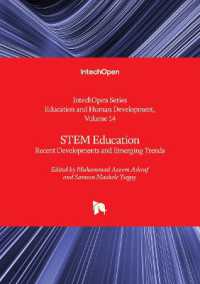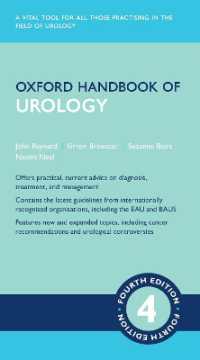- ホーム
- > 洋書
- > 英文書
- > Nature / Ecology
Full Description
This practical research text provides an invaluable resource for all animal and veterinary scientists designing, analysing and interpreting results from nutrition and feed experiments in pigs and poultry. The emphasis throughout is on practical aspects of designing nutrition experiments. The book builds on the basics and proceeds to describe the limitations of experiment design involving different ingredients. It goes on to describe the characterization of experimental diets including ingredient selection, composition and the minimum proximate analysis required. The text details measurements and the tools available for understanding diverse data sets, data analysis and eventual publication of the research. This fully balanced and extensively referenced, yet practical, text is an invaluable resource to all animal, veterinary and biomedical scientists involved in the designing of nutrition experiments in pigs and poultry, and the publication of their research.
Contents
-: Foreword 1: General Principles of Designing a Nutrition Experiment 1.1: Introduction 1.2: Nutrient Requirements Research 1.2.1: Environment 1.2.2: Cage versus pen and stocking density 1.2.3: Feed and water form and quality 1.2.4: Energy - amino acids, carbohydrates and fat 1.2.5: Fibre 1.2.6: Other nutrients 1.2.7: Age 1.2.8: Breed and sex 1.2.9: Disease status 1.3: Ingredient Nutrient Contents Research 1.3.1: Cereals 1.3.2: Oilseed meals 1.3.3: Fats 1.3.4: Vitamins and minerals 1.3.5: Additives 1.3.6: Digestibility studies 1.4: Summary 2: Most Common Designs and Understanding Their Limits 2.1: Introduction 2.2: What is the Goal of Simple Research Trials? 2.3: Typical Interpretations of Response Data 2.4: Choosing an Adequate (or the Best) Model to Use 2.5: How Much of a Good Thing is Too Much? 2.6: Variation in Bird Growth and Morphology 2.7: The Choice of an Experimental Unit 2.8: Experimental Power 2.9: More Complex Designs for More Complex Questions 2.10: Summary 3: Practical Relevance of Test Diets 3.1: Introduction 3.2: Commercially Relevant Animal Performance 3.2.1: Indices for measuring animal performance 3.2.2: Presentation of animal performance results 3.3: Feed Formulation 3.3.1: Nutritional considerations for feed formulation 3.3.2: Health considerations for feed formulation 3.3.3: Processing considerations for feed formulation 3.4: Summary 4: Characterization of the Experimental Diets 4.1: Introduction 4.2: Designing Diets: the Semi-synthetic Conundrum? 4.2.1: Sugars and starch 4.2.2: Fibres 4.2.3: Non-feed ingredients and phytate 4.3: Designing Diets: Describing Test Ingredients and an Appropriate Basal Diet 4.3.1: Trial design to compare one additive with a control 4.3.2: Trial design to compare two different additive products 4.4: Summary 5: Measurements of Nutrients and Nutritive Value 5.1: Introduction 5.2: In Vitro Measurements 5.2.1: Proximate analyses 5.2.2: Fibre and carbohydrates in feed 5.2.3: Summary 5.3: Determining Nutritive Value of Ingredients 5.3.1: In vivo experiments 5.3.2: Determining the digestibility of specific nutrients 5.3.3: Indirect measurements of digestibility 5.3.4: Summary 6: Designing, Conducting and Reporting Swine and Poultry Nutrition Research 6.1: Introduction 6.2: Planning the Experiment 6.2.1: Defining objectives 6.2.2: Written protocol 6.2.3: Review of facility capabilities 6.2.4: Statistical plan 6.2.5: Animal care standards and pig management 6.2.6: Data integrity 6.3: Interpreting Experimental Outcomes 6.4: The Experiment Report 6.4.1: Introduction 6.4.2: Materials and methods 6.4.3: Results 6.4.4: Discussion 6.4.5: Conclusions 6.4.6: Literature cited 6.5: Summary 7: Extending the Value of the Literature: Data Requirements for Holo-analysis and Interpretation of the Outputs 7.1: Introduction 7.2: Holo-analysis - Minimum Requirements 7.2.1: Considerations in use of data for holo-analysis 7.2.2: What makes a good model? 7.2.3: Model types 7.2.4: Modelling considerations 7.2.5: Outputs and interpretation 8: Presentation and Publication of Your Data 8.1: Publication Is Not the End of Your Research 8.2: Scientific Style - a Myth Laid Bare 8.3: Telling a Scientific Story 8.4: Structuring the Scientific Story 8.4.1: The Title 8.4.2: The Introduction 8.4.3: The Materials and Methods 8.4.4: The Results 8.4.5: The Discussion 8.4.6: The Summary 8.5: Scientific and Political Correctness 8.6: Which Journal Is Best for My Article? 8.7: Scientific Publication in the Future 8.8: Will New Forms of Publication Change the Way We Write?








